But a deeper look suggests that a legacy of racism and exclusion in San Francisco also played a key role.
Warriors’ history in fact starts in Philadelphia. A maverick of a man, Mieuli – a flamboyant radio and television producer known for his full beard and preference for motorcycles – got together with some investors who together bought and brought the team west to San Francisco in 1962.
Technically, the team’s home arena at the time was the “Cow Palace” in Daly City, a one-time venue for livestock expos built in 1941 just beyond the southern borders of San Francisco.
But between the years 1964 and 1966, the San Francisco Warriors played their “home games” in arenas and cities up and down the state. These included what is now San Francisco’s “Bill Graham Civic Auditorium,” as well as venues in Oakland, San Jose, Daly City and even six games in San Diego.
The city’s message to the team, which over nine years played home games in four different cities, was clear: “We don’t care about your basketball team!”
Further proof of that came in the fact that the team had the league’s worst attendance at the time, and this despite the Warriors’ reasonable success. In the 1966-67 season, the Warriors went all the way to the NBA finals, where they ironically lost to the team that replaced them in the city of Philadelphia, the 76ers. The Warriors also featured star players like Rick Barry and Nate Thurmond.
But the Warriors were also a team with an increasing number of Black athletes at a time of heightened racism in San Francisco and the rest of the country.
Many older San Franciscans, especially Black residents of the Bay View district remember the race riots of 1966 that were brought on by a white police officer shooting an unarmed Black teenager in the back. Things were so bad, in fact, that in 1964 San Francisco Mayor John Shelly formed the San Francisco Human Rights Commission to help fight discrimination against The City’s Black residents.
I have lived in San Francisco since 1960. When my father bought the family home in 1963, he was not able to purchase the Mission District house we lived in because of the color of his skin. Instead, he had to have a white lady friend be first on the deed. Prior to that, even Major League Baseball great, Willie Mays was not able to purchase a home in the affluent St. Francis Woods area of The City for the same reason.
It was under this atmosphere that, after being spurned by San Francisco, the Warriors ultimately found a home in Oakland in 1971. Over the ensuing decades the team developed a fan base known around the league for its devotion, despite the Warriors less than stellar record.
Now, more than 40 years later and San Francisco Mayor Ed Lee says he is bringing the “Warriors back home,” to a city that never wanted them in the first place.
The announcement for the Warriors’ move across the Bay first came in 2012, when Lee was joined by then-NBA Commissioner David Stern, California Lt. Gov. Gavin Newsom and Warriors’ owners Joe Lacob and Peter Guber. Since then plans have gone forward for a new arena located in the up-and-coming Mission Bay neighborhood, a once-dilapidated area along the city’s waterfront that, ironically, got a major renovation under San Francisco’s first Black mayor, Willie Brown.
Lee now wants to put his mark on that legacy by taking the Warriors from Oakland – a city with deep roots in the Black community – and bringing it to the more affluent – and arguably less diverse – San Francisco.
Opposition to the planned arena has come from all sides, Oakland fans among them, who worry they’ll be priced out of future games. The Mission Bay’s largest tenant, the University of California San Francisco, which operates a multi-billion dollar biotech research facility, has also spoken out against the arena. UCSF argues the new arena will create more congestion in an area that is already bursting at the seams.
Lee’s response has been to silence anyone at UCSF who opposes the Warriors project, part of his ambition for this “word-class city” is telling them to play ball for the team or else risk future funding.
Lee apparently believes San Franciscans are daffy enough to buy into his claim of city ownership, in support of his political “Legacy project” at the expense of a now 45 year legacy in Oakland. Given the Warriors recent success and wild popularity, perhaps they are.
But San Francisco, “everyone’s favorite city,” is now kicking dirt in the eye of its neighbor, Oakland, by taking a team that it once rejected. A world-class city helps its neighbors, it does not help itself to its neighbor’s jewels.
Allen Jones is a long time community activist and San Francisco resident. He is the driver behind the Good Neighbor Coalition, an initiative aimed at putting a measure on the 2018 ballot aimed at blocking the Warriors’ planned move to the city. (Image via Flickr Creative Commons.)



